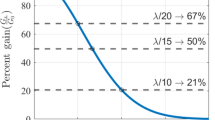Abstract
MUSTANG (Multiplex SQUID TES Array at Ninety GHz) is a bolometer camera for the Green Bank Telescope (GBT) working at a frequency of 90 GHz. The detector has a field of view of 40 arcsec. To cancel out random emission change from atmosphere and other sources, requires a fast scanning reflecting system with a few arcminute ranges. In this paper, the aberrations of an off-axis system are reviewed. The condition for an optimized system is provided. In an optimized system, as additional image transfer mirrors are introduced, new aberrations of the off-axis system may be reintroduced, resulting in a limited field of view. In this paper, different scanning mirror arrangements for the GBT system are analyzed through the ray tracing analysis. These include using the subreflector as the scanning mirror, chopping a flat mirror and transferring image with an ellipse mirror, and chopping a flat mirror and transferring image with a pair of face-to-face paraboloid mirrors. The system analysis shows that chopping a flat mirror and using a well aligned pair of paraboloids can generate the required field of view for the MUSTANG detector system, while other systems all suffer from larger off-axis aberrations added by the system modification. The spot diagrams of the well aligned pair of paraboloids produced are only about one Airy disk size within a scanning angle of about 3 arcmin.
Similar content being viewed by others
References
Jewell P R, Prestige R M. The Green Bank telescope. SPIE, 2004, 5489: 312–323
Norrod R, Srikanth S. A summary of the GBT optics design. NRAO GBT memo, 1996, 155: 1–22
Cheng J, Li X, Liang M, et al. Field of view and coma correction of a two mirror off-axis system. SPIE, 2010, 7733: 77335J(1)–77335J(7)
Cheng J Q. The Principles of Astronomical Telescope Design. New York: Springer, 2009
Mizugutch Y, Akagawa M, Yokoi H. Offset dual reflector antenna. In: Antennas and Propagation Society International Symposium. Amherst: IEEE, 1976. 2–5
Dragone C. A first-order treatment of aberrations in Cassegraneian and Gregorian antennas. IEEE Trans, 1982, 30: 311–339
Rusch W V T, Prata A J, Rahmat-Samii Y, et al. Derivation and application of the equivalent paraboloid for classical offset Cassegrain and Gregorian antennas. IEEE Trans, 1996, 38: 1141–1149
Noethe L, Guisard S. Analytical expressions for field astigmatism in decentered two mirror telescopes and application to the collimation of the ESO VLT. Astron Astrophys, 2000, 144: 157–167
Chang S, Prata A J. Geometrical theory of aberrations near the axis in classical off-axis reflecting telescopes. Opt Soc Am J A, 2005, 22: 2454–2464
Chang S. Off-axis reflecting telescope with axially symmetric optical property and its applications. SPIE, 2006, 6265: 626548(1)–626548(8)
Norrod R, Srikanth S. Field of view of the GBT at 90 GHz. NRAO GBT memo, 1999, 199: 1–9
Wilson R N. Reflecting Telescope Optics I. 2nd ed. Berlin: Springer, 2004
Author information
Authors and Affiliations
Corresponding author
Rights and permissions
About this article
Cite this article
Cheng, J., Li, Y., Li, X. et al. Field scanner design for MUSTANG of the Green Bank Telescope. Sci. China Phys. Mech. Astron. 54, 2091 (2011). https://doi.org/10.1007/s11433-011-4477-8
Received:
Accepted:
Published:
DOI: https://doi.org/10.1007/s11433-011-4477-8




